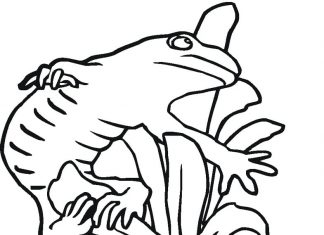Salamanders are a group of amphibians with distinctive structures and behaviors. They are often confused with lizards because of their appearance, but are more closely related to frogs and newts.
Salamander coloring pages
information
- Body structure: Salamanders have a distinctive body structure, with a long tail and short limbs. They have soft skin, and some species have bright or toxic patterns that serve as a warning to predators.
- Skin and toxins: Some species of salamanders produce toxins in their skin as a defense against predators. These toxins can be dangerous to animals and humans, which is why brightly colored salamanders often signal their toxicity.
- Aquatic and terrestrial life: Many salamanders spend part of their lives in water, while others are more adapted to life on land. Unlike frogs, which undergo a transformation from tadpole to adult, salamanders undergo a less spectacular transformation.
- Regenerative Tail: Salamanders have the ability to regenerate their tails. If they lose their tails, they can regrow them in a matter of weeks or months.
- Nutrition: Most salamanders are carnivorous, feeding on insects, earthworms, small fish and other small animals.
- Giant Salamanders: There are species of salamanders that reach considerable size, such as the giant salamander (Cryptobranchus alleganiensis), which can reach a length of more than 60 cm.
- Threats: Some salamander species are threatened with extinction due to habitat loss, water pollution and fungal diseases such as chytridiomycosis.
- Salamanders in research: Salamanders are the subject of scientific research because of their regenerative ability, the understanding of which may have applications in regenerative medicine.
- Legends and Mythology: In some cultures, salamanders were considered magical creatures and appear in various myths and legends.
- Conservation and breeding: Due to their uniqueness and role in ecosystems, some species of salamanders are included in conservation programs. Some species of salamanders can be found as exotic pets in domestic animal farms.
trivia
- Limb regeneration: Salamanders are known for their ability to regenerate lost limbs. They are one of the few animals that can restore fully functional limbs after losing them.
- Toxic skin: Some species of salamanders produce potent toxins in their skin as a defense mechanism. One example is the spotted salamander (Salamandra salamandra), which can secrete neurotoxins.
- The only family: Salamanders are one of the three main families of tailed amphibians, along with newts and toads. Unlike newts, which go through a tadpole stage, salamanders behave more primitively in terms of transformation.
- Life underground: Some species of salamanders, called giant cave salamanders, live mainly in caves and are adapted to living in total darkness.
- Camouflage and mimicry: The skin of some salamander species can have colors and patterns that mimic their surroundings, which helps them camouflage themselves. Some species mimic the appearance of other, more toxic animals to deter potential predators.
- Long life: Some species of salamanders can live quite long. For example, the Japanese giant salamander (Andrias japonicus) can live up to 50 years.
- The spotted salamander in heraldry: The spotted salamander was historically depicted in coats of arms as a symbol of resistance to fire. In fact, the name "salamander" comes from the Greek word meaning "fire".
- Water eggs: Most species of salamanders lay their eggs in the water, where the larvae develop to a juvenile stage that resembles an adult. However, some species give birth to fully formed young.
- The spotted salamander as a symbol: The spotted salamander has become a symbol of sustainability in some areas of France, thanks to its ability to recover from forest fires.
- Endangered species protection: Many species of salamanders are threatened with extinction due to habitat loss, climate change and other factors. Therefore, many organizations are taking steps to protect these interesting creatures.










